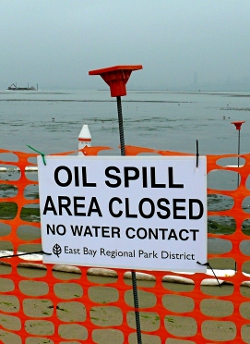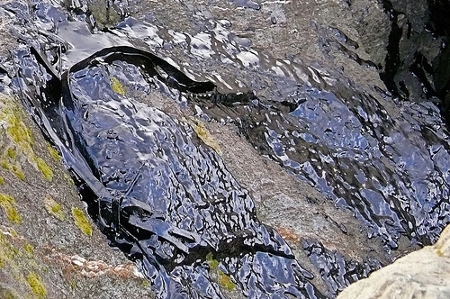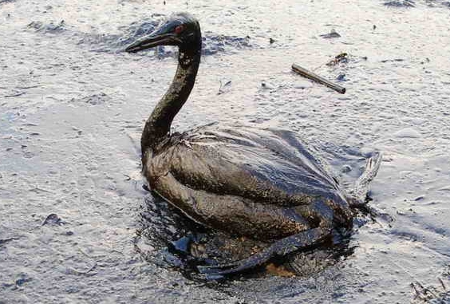Lesson Plan: Oil Spill Solutions
 (Lesson plan courtesy of Tryengineering.org. View the pdf.)
(Lesson plan courtesy of Tryengineering.org. View the pdf.)
Grade Level: 3-12. Duration: Two to three 45-min. sessions
Overview
This lesson focuses on how engineers use various techniques to provide speedy solutions to oil spills or other threats to natural water resources. Students work in teams to analyze an “oil spill” in the classroom, then design, build, and test a system to first contain, and then remove the oil from the water. Students select from everyday items to build their oil containment and clean-up systems, evaluate the effectiveness of their solution and those of other teams, and present their findings to the class.
Objectives
- Learn about environmental engineering.
- Learn about chemistry and chemical engineering.
- Learn about engineering design.
- Learn about planning and construction.
- Learn about teamwork and working in groups.
As a result of this activity, students should develop an understanding of environmental engineering, problem solving, and teamwork.
Lesson Activities
Students learn how environmental engineers develop equipment and procedures to help reduce environmental impact from accidental oil spills. Students work in teams to design and build a system out of everyday items that will eliminate oil from a classroom waterway. They test their system, evaluate their own results and those of other students, and present their findings to the class.
Standards
This lesson plan is aligned to the National Science Education Standards produced by the National Research Council and endorsed by the National Science Teachers Association, and to the International Technology Education Association’s Standards for Technological Literacy.
National Science Education Standards Grades K-4 (ages 4 – 9)
CONTENT STANDARD A: Science as Inquiry – As a result of activities, all students should develop abilities necessary to do scientific inquiry.
CONTENT STANDARD C: Life Science – As a result of the activities, all students should develop understanding of organisms and environments.
CONTENT STANDARD D: Earth and Space Science – As a result of their activities, all students should develop an understanding of properties of earth materials.
CONTENT STANDARD E: Science and Technology – As a result of activities, all students should develop abilities of technological design and understanding about science and technology.
CONTENT STANDARD F: Science in Personal and Social Perspectives – As a result of activities, all students should develop understanding of changes in environments and science and technology in local challenges.
National Science Education Standards Grades 5-8 (ages 10 – 14)
CONTENT STANDARD A: Science as Inquiry – As a result of activities, all students should develop abilities necessary to do scientific inquiry.
CONTENT STANDARD B: Physical Science – As a result of their activities, all students should develop an understanding of properties and changes of properties in matter.
CONTENT STANDARD C: Life Science – As a result of their activities, all students should develop understanding of structure and function in living systems and of populations and ecosystems.
CONTENT STANDARD E: Science and Technology – As a result of activities in grades 5-8, all students should develop abilities of technological design and understandings about science and technology.
CONTENT STANDARD F: Science in Personal and Social Perspectives – As a result of activities, all students should develop understandings of populations, resources, and environments; risks and benefits; and science and technology in society.
National Science Education Standards Grades 9-12 (ages 14 – 18)
CONTENT STANDARD A: Science as Inquiry – As a result of activities, all students should develop abilities necessary to do scientific inquiry and understandings about scientific inquiry.
CONTENT STANDARD C: Life Science – As a result of their activities, all students should develop understanding of matter, energy, and organization in living systems and behavior of organisms.
CONTENT STANDARD E: Science and Technology – As a result of activities, all students should develop abilities of technological design and understandings about science and technology.
CONTENT STANDARD F: Science in Personal and Social Perspectives – As a result of activities, all students should develop understandings of environmental quality, natural and human-induced hazards, and science and technology in local, national, and global challenges.
CONTENT STANDARD G: History and Nature of Science – As a result of activities, all students should develop understanding of science as a human endeavor
Standards for Technological Literacy – All Ages
The Nature of Technology – Standard 1: Students will develop an understanding of the characteristics and scope of technology.
Technology and Society – Standard 5: Students will develop an understanding of the effects of technology on the environment. Standard 6: Students will develop an understanding of the role of society in the development and use of technology.
Design – Standard 9: Students will develop an understanding of engineering design. Standard 10: Students will develop an understanding of the role of troubleshooting, research and development, invention and innovation, and experimentation in problem solving.
Abilities for a Technological World – Standard 11: Students will develop abilities to apply the design process.
The Designed World – Standard 15: Students will develop an understanding of and be able to select and use agricultural and related biotechnologies.
Materials
- Student Resource Oil (pdf)
- Student Worksheet (pdf)
- Water basin or sink for testing
- “Oil” (use 1⁄2 cup vegetable oil mixed with cocoa powder to create the sense of crude oil)
- One set of materials for each group of students:
Rubber bands, paper towels, string, toothpicks, cotton balls, plastic wrap, popsicle sticks, shredded wheat cereal, balloons, cooked rice, garden peat moss, grass, cork, suction tube/cooking baster, spoon, other items.
Procedure
1. Distribute to students the Student Resource sheet. These may be read in class, or provided as reading material for the prior night’s homework.
2. Divide the class into groups of 2-3 students, providing a set of materials for each group.
3. Explain that students must work as a team to design a system to clean up after an oil spill. The spill will be a controlled 1⁄2 cup of vegetable oil that is poured into water which is held in a container such as a water trough, large bucket, or sink.
4. Students meet and develop a two tiered plan to first contain the oil and then to remove it. They can select from a range of everyday items provided to serve as their tools. Student teams will describe their plan in writing and with a drawing and then present their plan to the class. Plans may be adjusted after feedback from others during the presentation stage.
5. Student groups next execute their engineered clean-up system step-by-step as described in their plan. Student clean-up systems will be scored on the following scale indicating how “clean” the water is after clean-up:
| Water is completely clear of all oil | About a quarter of the oil remains | About half of the oil remains | About three quarters of the oil remains | No change, water is as oily as at the beginning of the challenge |
|
0 |
1 |
2 |
3 |
4 |
6. Teams then complete an evaluation/reflection worksheet, and present their findings to the class.
Troubleshooting
Be sure to stress that the “clean” water, no matter how clear, is not suitable for drinking.
Teams may require additional materials which they will request of the teacher, or they can be encouraged to exchange building materials with other teams.
Extension Ideas
Set a budget for the project, assigning a cost to each material, and requiring teams to “buy” materials from the teacher to create their filtration system.
Time the challenge, with the speed of the clean-up factored into the success of the design.
Give a demonstration of the same oil spill, adding several drops of detergent to the oil. Have students observe what happens and then record notes as to why they think the oil dispersed. Challenge them to consider whether adding detergent is a viable solution for a real oil spill. The reason dish soap is so effective is that the soap emulsifies and chemically reacts with the oil to hydrolyze it. This is referred to as the “saponification” reaction. The soap will chemically react with the oil to both make it water soluble and will emulsify it, or break it into smaller drops so it can be cleaned more effectively.
Have students write an essay or a paragraph about how systems developed by engineers in advance of a natural disaster (earthquake) or human-induced disaster (oil spill) can help speed recovery of both the environment and society.
Web Resources
TryEngineering
Oil Spill Recovery Institute
NOAA’s National Ocean Service Office of Response and Restoration
ITEA Standards for Technological Literacy: Content for the Study of Technology
National Science Education Standards
Supplemental Reading
The Oil Spill Recovery Institute: Past, Present, and Future Direction (ISBN: 0309085144)
The Basics of Oil Spill Cleanup (ISBN: 1566705371)
Oil Spills (Our Environment Series) (ISBN: 0737726296)
Student Resource Sheet: What is an Oil Spill?
An oil spill is an accidental release of liquid petroleum hydrocarbons (usually during transportation of oil) into the environment. Oil spills usually refer to the release of oils into water, but of course an oil spill can take place on land as well. While spills can take place quickly, as when a ship sinks, or a leak occurs in a pipeline, the cleanup can be a long term project. And, the longer the oil sits in the water, the greater the impact on the environment.
Environmental Impact
Birds are one of the creatures impacted by oil spills. Oil can sink into and reduce the functionality of bird feathers. A bird’s feathers provide insulation, so a bird exposed to oil will be exposed to temperatures they are not used to. It also makes it difficult for a bird to float or fly, so the bird will be more vulnerable to animals of prey, or the bird may not be able to move to find food or clean water. Birds try to clean themselves, and if they do they are likely to ingest some of the oil which can cause damage to internal organs. Most birds impacted by an oil spill die unless humans step in and help clean them.
Many organizations work to save these animals. More information is available at the “Oiled Wildlife Care Network” at the University of California, Davis or the International Bird Rescue Research Center. Birds are not the only creatures put at risk by oil spills. Marine mammals such as seals and otters gain insulation benefits from their fur. As oil permeates the fur, they are potentially exposed to temperatures beyond their normal range. It is important to act quickly when a spill occurs to lessen the impact of the spill on the natural environment. Environmental engineers are often called upon to come up with planned solutions in advance of a spill, or to customize systems bases on a specific event.
Engineering Trade-offs
In order to reduce the chances of an oil spill, engineers have developed new ship designs with double — and even triple — hulls. The oil is stored in the most interior hull, so that if there was a leak, it would be captured in the next outer hull. Of course, these multiple hulled ships are more expensive to build and operate, so a company will have to weigh the advantages and disadvantages of ship engineering in order to come up with a plan that meets safety requirements, but also does not increase the cost of the shipped product more than the market can bear.
Clean-up Methods
There are many types of cleaning methods used for spills, including:
- Bioremediation: using microorganisms or biological agents to break down or remove oil
- Dredging: some oils are actually denser than water, and would sink. These would require cleaning below the surface of the impacted water.
- Skimming: can be effective areas where the water is calm.
- Dispersion: materials such as some detergents can disperse oil into smaller clusters that may be easier to remove than larger areas. However, the detergents can sink deeper into the water than oil does, so it may cause harm deeper in the water while reducing negative environmental impact on the surface.
- Burning: controlled burning can often eliminate a large proportion of oil in water, but of course requires great care to avoid having the fire spread. The burning oil can also cause air pollution.
Student Worksheet
For a more formatted, easier to print version of this worksheet with extra spacing, visit here.
You are part of a team of engineers who have been given the challenge of first containing, and then cleaning up an oil spill. You will have many materials available to you, but will have to come up with a strategy to remove as much oil as possible.
Planning Phase
Meet as a team and discuss the problem you need to solve. Then develop and agree on a plan for your containment system. Next develop a plan for cleaning up the oil you have contained. You may have to consider stages or steps you might take and determine which order you will execute different steps. You have been provided with many items you may use for your system. You don’t need to use all the items, and should only use those that you think will work the best. Write a description of your containment and clean- up systems in the boxes below. Draw a sketch of what you plan to do. Be sure to indicate the materials you anticipate using. Present your design to the class. You may choose to revise your teams’ plan after you receive feedback from class.
| Containment System
SPACE SPACE SPACE SPACE SPACE SPACE SPACE Materials Required: |
Clean-up System
SPACE SPACE SPACE SPACE SPACE SPACE
Materials Required: |
Preparation Phase
Gather all the materials you plan to use, and consider how you will use them and what steps might need to be taken. You may need to ask for additional materials during this phase as you consider how much oil you have to clean-up!
Testing Phase
Each team will have a chance to test their containment and clean-up systems on a similar “oil spill.” Be sure to watch all the methods and observe the different approaches your classmates have “engineered.” See which procedures worked best — it may be that certain parts of a procedure worked better than others. Each system will be scored on the following scale to determine success.
| Water is completely clear of all oil | About a quarter of the oil remains | About half of the oil remains | About three quarters of the oil remains | No change, water is as oily as at the beginning of the challenge |
|
0 |
1 |
2 |
3 |
4 |
Evaluation Phase
Evaluate your team’s results, complete the evaluation questions, and present your findings to the class.
1. Did you succeed in removing all the oil from the “oil spill?” What was the score your team achieved?
2. If your system failed, what do you think went wrong?
3. Describe a system another student team created that you thought worked well. What did you do differently?
4. How did your decisions on engineering trade-offs differ from that team? What goals or priorities for your system did you put above others?
5. Did you decide to revise your plan while actually doing the containment or clean-up? Why? How?
6. Why might a team of environmental engineers change their planned approach to an oil spill clean-up once they arrived on the site? Do you think it is common that professionals change their plans while on the job?
7. If you had to do it all over again, how would your team have improved your containment system? Why?
8. If you had to do it all over again, how would your team have improved your clean-up system? Why?
9. Do you think that experience with prior oil spills would make a team of engineers more able to address the next unexpected one?
10. Now that you have learned about the different trade-offs engineers must factor into a product or system, if you were designing a new rail-based oil transportation system, what considerations would you have to balance in your new design (consider costs, environmental issues, public health, speed of transport)?
11. What other materials do you think would have helped speed up your containment or clean-up?
Filed under: Grades 6-8, Grades 9-12, Grades K-5, Lesson Plans
Tags: Energy and Environmental Technology, Environmental Engineering, Environmental science, Grades 3-12, Ocean










